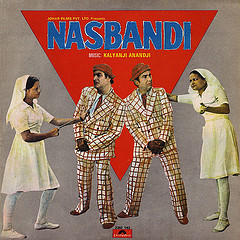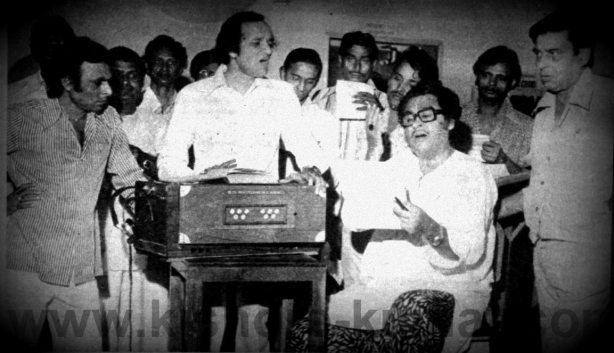 Emergency was imposed on India on this day 42 years ago, on June 25, 1975, and it lasted for about 21 months. During the emergency, Kishore Kumar was banned by Ministry of I&B on All India Radio & Doordarshan for his non-participation in one of the major public events organised by the people in power then.
Emergency was imposed on India on this day 42 years ago, on June 25, 1975, and it lasted for about 21 months. During the emergency, Kishore Kumar was banned by Ministry of I&B on All India Radio & Doordarshan for his non-participation in one of the major public events organised by the people in power then.
When Emergency was finally revoked in 1977, India opted to form a new Government, the country saw a big turn around and supported Janta Party coalition. With Janta Party in power, Kishore Kumar sang a protest song for the film Nasbandi (1978) and scored an interesting musical revenge. The film was produced & directed by IS Johar.
The film version of the song was censored and curtailed for a stanza featuring names of some politicians. The antagonistic lyrics were penned by Indeevar and the song was composed by Kalyanji-Anandji. An unusual musical documentation of an important event in modern history.

Kishore da recording the song with Kalyanji-Anandji. IS Johar can be seen too
– Pic credits: Kaustubh Pingle
Full Lyrics :
जनता की आवाज़ है ये
सुन ले ओ बापू गांधी
ये कैसा हाहाकार देश मे
ये कैसी आग की आंधी
कहां गयी वो तेरी अहिंसा, कहां गया वो प्यार
गांधी तेरे देश में ये कैसा अत्याचार
बापू तेरे देश में ये कैसा अत्याचार
इक भारत में बन गये जलियांवाले बाग़ हज़ार
बापू तेरे देश मे ये कैसा अत्याचार
तूने जब आवाज़ लगाई, सारा हिंदुस्तान उठा
अंग्रेज़ों के दिल भी दहले, ऐसा इक तूफ़ान उठा
खुशी-खुशी तेरे कहने पर भारतवासी जेल गये
सीने पे गोली झेल गये, अपने प्राणों पर खेल गये
नाम पे तेरे लाखों जवां, दुनिया के सब सुख भूल गये
दुल्हन का घूंघट बिन खोले ही फांसी पर झूल गये
तू स्वराज ले आया, हम तो फिर भी रहे लाचार
गांधी तेरे देश में ये कैसा अत्याचार
आज़ादी की जंग लड़ा था क्या इसीलिये ये हिन्दुस्तां
अरे न्याय मांगने न्यायालय मे जा ना सके कोई इंसान
कितने ही निर्दोष यहां ’मीसा’ के अन्दर बन्द हुए
अंधे कुएं में कितने ही आज़ाद समंदर बंद हुए
इस्मत लूटा करते हैं जो बन कर लाज के पहरेदार
अपनी सत्ता रखने को जो छीने जनता के अधिकार
सौंप गया है ऐसे के हाथ मे देश की क्यों पतवार
गांधी तेरे देश मे ये कैसा अत्याचार
देखी कहीं कलमबन्दी, देखी कहीं ज़ुबांबन्दी
डर की हुकुमत हर दिल पर थी, सारा हिन्दुस्तां बन्दी
नसबन्दी के नाम पे जुल्म हुए वो दुखियो दीनों पर
लगता था लटका हो जैसे प्रजातन्त्र संगीनों पर
तुर्कमान वो आस्मां टूटा जहां ज़मीनों पर
चढ़ा दिये जब बुलडोज़र जब बेबस लोगों के सीनों पर
अपनो के हाथों ही अपनों पर गोली की बौछार
गांधी तेरे देश मे ये कैसा अत्याचार
सारे देश पर ज़ुल्मो-सितम के घोर अन्धेरे जब छाए
तब प्रकाश की किरणें लेकर जय प्रकाश आगे आए
विजय लक्ष्मी पंडित ने जनता का मनोबल बढ़ा दिया
राज नारायण ने नामुमकिन, मुमकिन करके दिखा दिया
मज़हब से कम नहीं मुल्क, बोले जामा मस्जिद के इमाम
प्रजातन्त्र को नव-जीवन देने आये जगजीवन राम
जॉर्ज फ़र्नांडिस तोड के आये इल्ज़ामों की जन्ज़ीरें
श्रीमोरारजी के आने से चमक उठी फिर तकदीरें
चरन सिंह और चन्द्रशेखर ने लोगों के दिलों को जीता
वापस ले आई जनता अपनी आज़ादी की सीता
अटलबिहारी, आडवानी, नाना ने किया उद्धार
गांधी तेरे नाम की अब होगी जय-जयकार
अरे जो भी हुकुमत ज़ुल्म करेगी उसकी होगी हार
जो भी हुकुमत ज़ुल्म करेगी उसकी होगी हार
–
फ़िल्म : नसबन्दी -1978
गायक : किशोर कुमार & कोरस
गीतकार : इंदीवर
संगीतकार : कल्याणजी-आनंद्जी






















